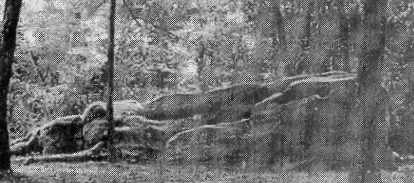
This bounder located north of Hwy. 70 in Hollow Rock, Tenn.
has puzzled geologists who cannot type the composition of the
rock. It was 45 ft. long, 13 ft. wide, and 12 ft. high although
today it has sunk into the ground and been affected by erosion.

Good Thursday morning. After the little shower last night, all the plants look fresh and perky. We do need more rain though, but I'm thankful for what we did get. Hope all a nice week.
I was asked if I would write a history of Hollow Rock, Tennessee. Thanks to Lillian C. Rice for giving me permission to use some of her information she has printed.
Before 1867, the town of Hollow Rock did not exist. In this year the Nashville and Northwestern Railroad was completed, so a station and telegraph office were opened and given the name Hollow Rock, taking its name from a large rock nearby. The rock was near the railroad and people say that hobos would jump off the train to sleep and cook in the hollow rock. Several attempts have been made to find the bottom of this rock, but no success.
In the early 1900's, on top of the ground, the stone was 456 feet long, 13 feet wide, and 12 feet high. Today the rock has sunk into the ground with only a very small opening showing. Around 1915-1020 an all-day gathering was held at the hollow rock on the first Sunday in May. Over a hundred people attended from far and near. My daddy Willie Melton, who lived in Harmon Creek in Benton County, has told me of hitching up his mule when he was a teenager and riding to the hollow rock for this big event.
Geologist have studied the rock and do not know what minerals it contains, since no other rock of its kind has been found. Some think it was a meteorite that fell from the sky many years ago.
Before Hollow Rock came into existence, a small settlement named Sandy Bridge was established in 1830. It was locate a few feet east of the present day Prospect Baptist Church. The settlement has a post office and a log inn.
Andrew and Lucinda McMackins owned a 67-acre tract of land adjacent to Sandy Bridge. In 1867, they had this land laid off in streets and numbered the lots.
The town of Hollow Rock was chartered and incorporated on February 3, 1869, and the streets were given names such as Front Street, Main, Spring, Cemetery (later changed to Seminary). Depot (which is now a gully), and Hotel Street, which was named for a hotel that was started but never finished.,
The first recorded deed was to N.B. Lipe. Andrew and Lucinda both signed this deed. Andrew died before others were signed and all thereafter were signed by Lucinda. Both are buried in a private cemetery on the North end of Spring Street.
N.B. Lipe built a store and a dwelling. Others started buying lots and establishing businesses, one being S.W. Muzall, later known as Uncle Steve. He had been an officer in the Confederate defeat at island number 10. He escaped capture by crossing Reelfoot Land, swimming from one Cypress stump to anther.
Before Hollow Rock was chartered it had several saloons, and eighteen men were killed in Hollow Rock. One of the saloons was called Yellow Front.
The tow's first doctor was Dr. Joe T. Henslee, a brother-in-law to N.P. Lipe. He began practicing medicine in 1868. This was also before Hollow Rock was chartered.
After being incorporated in 1869 and streets being named, for some reason it was again unincorporated. In 1911 the town was again unincorporated, with F.A. Penick as mayor. Dr. L.L. Duncan was a doctor in Hollow Rock before his death in 1945.
Before 1875 there was a small school operation. In 1875 another school was built and remained until 1887. It was then moved and rebuilt as two room school, and a two story building was built in 1919. In 1927 the Hollow Rock-Bruceton Central High School was built. More was added to this building and in 1980 all grades attended this school
A missionary Baptist Church was organized in 1846, and it stood on the site where the present day Prospect Church stands. In 1875 a Methodist Church was built.
In 1885 a hotel was built. In 1920 the railroad took over the street for the siding. This made in inconvenient for the cars to park around the hotel. Mrs. J.R. Presson was running a boarding house, which enlarged and thus entered the hotel business. It became a thriving business. After her death in 1930 it became an apartment house. Bob Presson, her husband
Thought for the Week:
Our present choices determine our future rewards.
Continued next week...
Server space for the TNGenWeb Project is provided through the generosity of US Internet.
The TNGenWeb Project makes no claims or estimates of the validity of the information submitted and reminds you that each new piece of information must be researched and proved, or disproved by the weight of evidence.
You are welcome to copy information found on the Benton County TNGenWeb site for personal use, and share information with other researchers or genealogical organizations, but this information may not be sold or used in a commercial project without expressed permission. All material submitted by individuals for inclusion in this site remains their property.